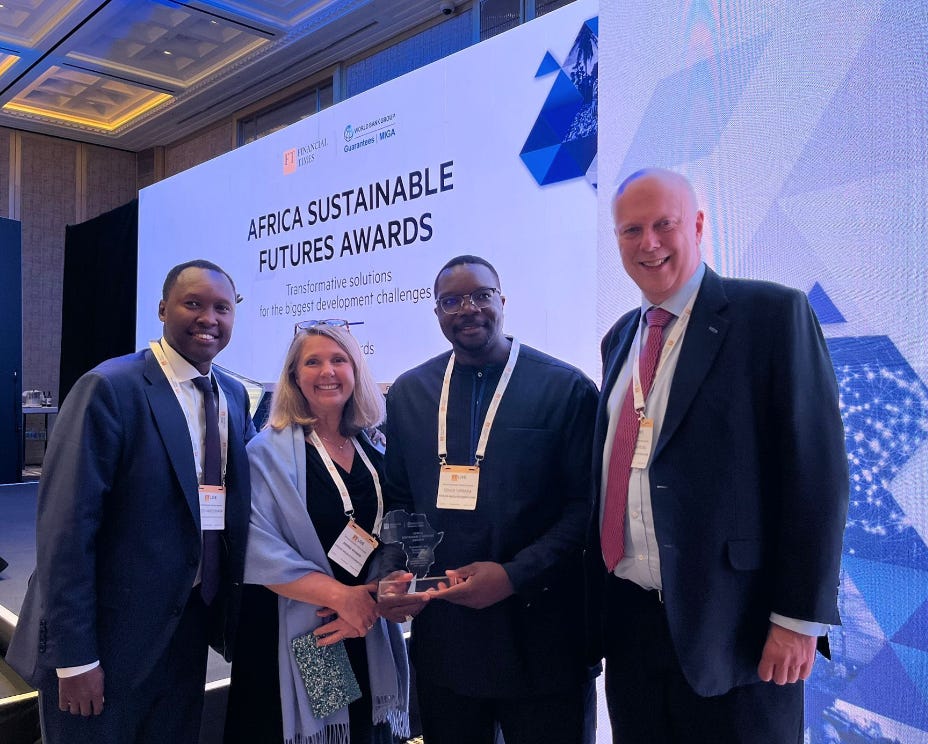The Financial Times and the World Bank Group recently opened the second Africa Sustainable Futures Awards, a continent-wide competition designed to surface commercially viable projects that deliver jobs, resilient infrastructure and measurable environmental outcomes. Running alongside the FT’s Africa Summit in London, the programme will judge initiatives launched since 2015 on impact, replicability and financial soundness, with winners announced at a ceremony on 22 October 2025; organisers have set eligibility thresholds of at least US$3 million in annual revenue or US$5 million in investment, while an Innovation Showcase permits earlier-stage entrants.
The awards shortlist reads like a snapshot of where private capital is actually being deployed across Africa: electrification platforms supplying rural households and town centres, agribusiness models tying smallholders into processing chains, health-tech and logistics ventures that cut operating costs and extend services, and manufacturing ventures that keep value on the continent. Taken together, these projects illuminate a practical route from project-level innovation to broader systemic change, but they also highlight the scale and sequencing required to move from pilots to national impact.
Read also: Africa mourns Raila Odinga: Architect of Kenya’s reforms and Pan-African visionary
Consider energy; Husk Power operates nearly 100 solar mini-grids in Nigeria and reports serving half a million customers; its “Africa Sunshot” aim to build 2,500 systems by 2030 would require capital, permitting and distribution logistics sufficient to replicate that footprint across at least six additional countries. NOA Group, backed by about US$220 million in equity, is aggregating 750MW of projects under construction in South Africa with a 5GW target by 2030. Those two efforts illustrate complementary strategies; community-scale supply on one hand, utility-scale aggregation on the other, yet both depend on predictable tariffs, access to local currency finance and grid-integration standards that many jurisdictions still lack.

Urban mobility is another practical battleground. BasiGo’s pay-as-you-drive e-bus model has placed more than 100 electric minibuses in Kenya and Rwanda, claiming avoidance of roughly 2,600 tonnes of CO₂ and displacement of 1.4 million litres of diesel to date. Roam’s locally manufactured electric motorcycles have deployed about 3,000 units and established 10 charging hubs, generating some 300 jobs. These numbers show demand and early operational viability, but scaling to the hundreds of thousands of vehicles required to change urban fleets will hinge on manufacturing supply chains, battery recycling capacity and financing structures tailored to informal operators who currently run most passenger transport across African cities.
Read also: Paris Agreement Crediting Mechanism could squeeze small players from Africa’s carbon market
Agribusiness entries show a similar pattern: Hello Tractor’s data-driven pay-as-you-go mechanisation platform has issued over 300 loans worth US$15 million and connects 2.5 million farmers to tractor services in 20 countries; Cameroon’s Cayenne Pepper cooperative couples seed, drip irrigation and processing to capture value locally; Terraformation’s Seed to Carbon Accelerator links reforestation with access to carbon finance across Ghana, Cameroon, Kenya and Tanzania. Each model presents measurable gains, yield uplifts, reduced post-harvest loss, or verified carbon sequestration, but too often national policy and trade logistics blunt the commercial upside. Shipping delays, customs holdups for agro-processors, or absence of domestic carbon market rules can convert a bankable project into an export bottleneck.
Health and digital infrastructure on the shortlist underline how operational design matters. Penda Health’s AI Consult tool now runs at 15 clinics and across more than 40,000 visits, reducing diagnostic and treatment errors; Liquid SA’s Eastern Cape broadband build has connected 1,300 schools and 347 clinics and created nearly 8,000 jobs under a ZAR900 million blended-finance structure. These projects demonstrate that linking service delivery with durable revenue models, user fees, government contracts or service subscriptions, is essential if gains are to persist beyond donor cycles.
Finance is the connective tissue. The Nigeria Infrastructure Debt Fund has financed US$351 million in loans that catalysed over US$600 million in infrastructure delivery; the World Bank Group’s Guarantee Platform, now housed at MIGA, has signalled a push to scale guarantee issuance towards US$20 billion annually by 2030. Private investors in the shortlist are already committing equity and debt, MOPO reports over 30 million battery rentals across six countries; Raxio is expanding data centres across Uganda, Ethiopia, DRC and beyond, yet these flows are uneven and often local-currency constrained.
Read also: Kenya revives Galana Kulalu irrigation scheme as first Maize harvest begins under PPP model
Two practical implications follow; First, projects that combine measurable unit economics with institutional buy-in, standardized offtake, verified local content, integrated monitoring, are the ones most likely to transition from national pilots to regional scale. Second, the enabling conditions remain procedural and granular: interoperable digital payment rails, standardized procurement templates for mini-grids, customs simplification for processed agricultural exports, and predictable duties for renewable components. These are the levers that turn a $5 million demonstration into a $500 million program.
The awards’ eligibility rules reflect an impatience with concept-stage ideas: only initiatives with demonstrable revenues or investment qualify for core categories, while the Innovation Showcase keeps a space for early entrants. That framing matters because many African development priorities; electrification, industrial jobs, climate adaptation, require commercial discipline as much as philanthropic support.
The shortlist itself suggests practical priorities for governments and financiers: reduce transaction costs for small infrastructure projects; align procurement and permitting across borders to enable inter-country corridors; and expand de-risking products in local currency. The next step is not more lists of promising pilots but the patient work of harmonising standards, unblocking trade frictions, and matching technical assistance to capital. The FT-World Bank Awards will surface success stories; scaling them will demand that public policy and private capital align around the nitty-gritty of execution.






